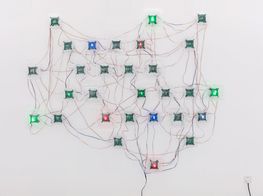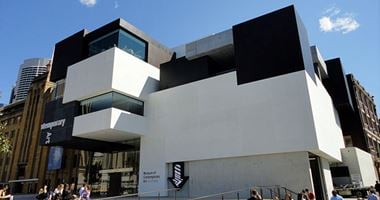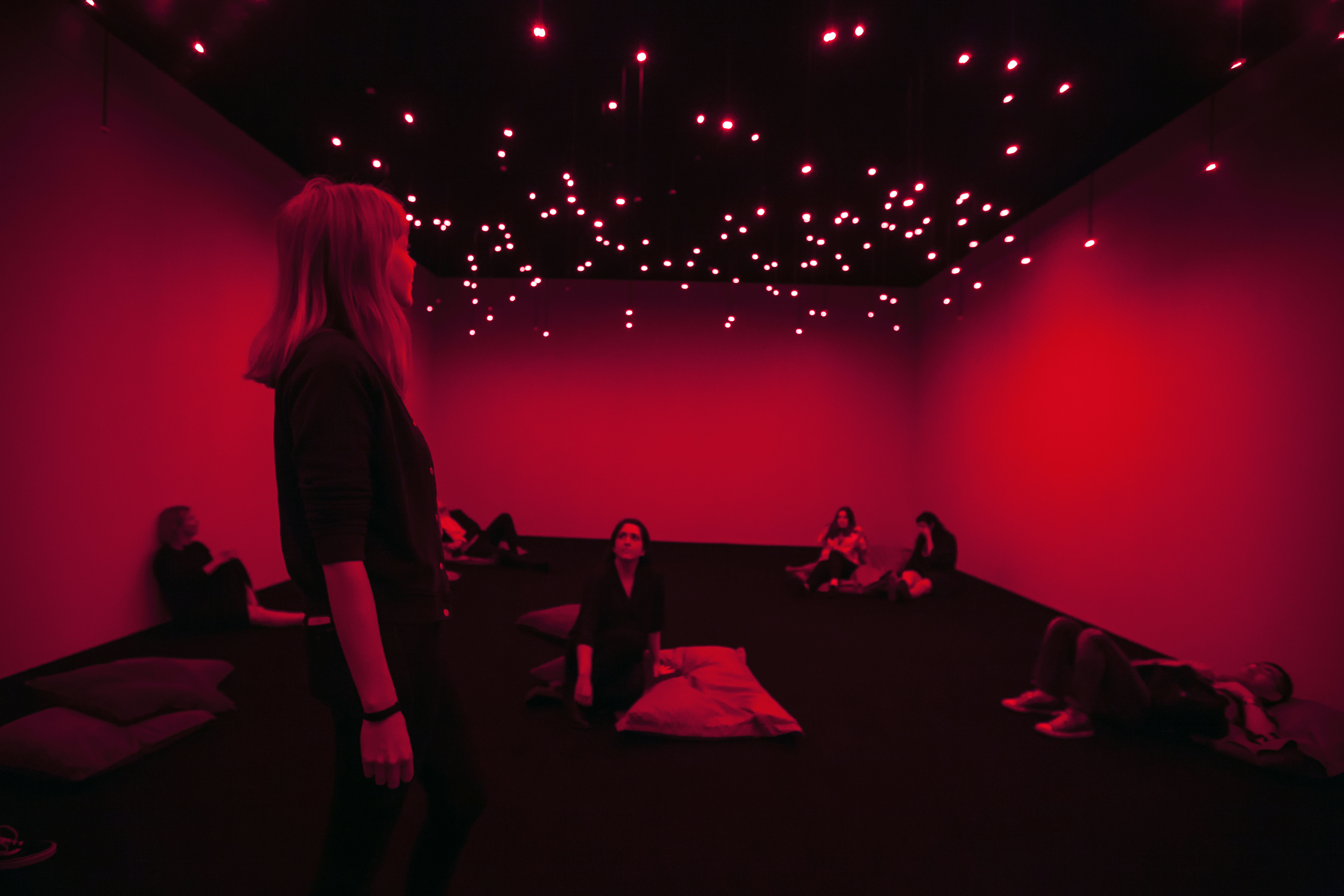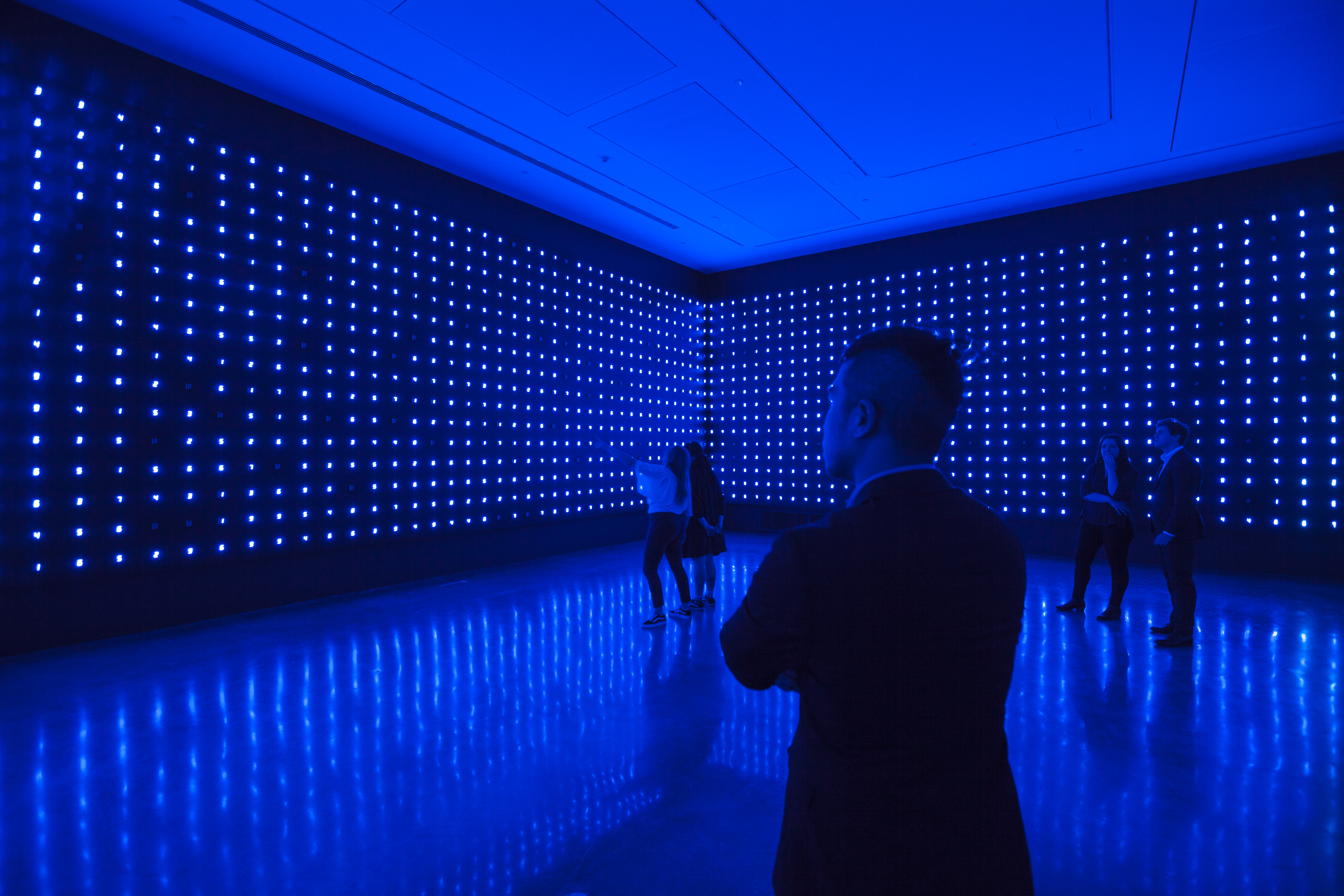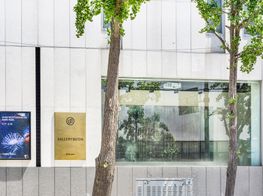Tatsuo Miyajima
Tatsuo Miyajima at the MCA in front of Mega Death. Photo: Anna Kučrea.
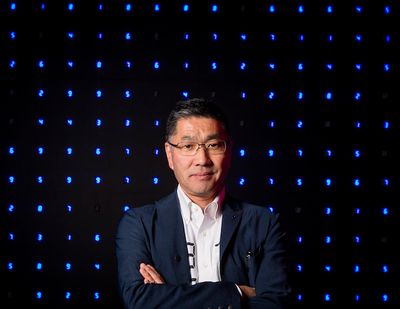
Tatsuo Miyajima at the MCA in front of Mega Death. Photo: Anna Kučrea.
Every artist has a lover. Yves Klein has blue. Louise Bourgeois has the spider. Ed Ruscha has words. The Japanese artist Tatsuo Miyajima has numbers; he paints them on the folds of bright kimonos, he draws them in sketchbooks, he fills walls, floors, pools of water and piles of coal with glowing numerals.
His shirts are tailor made with numbers that fall from their lapels to their chest. Miyajima has adopted the light-emitting diodes of Tokyo's Akihabara district as his vocabulary, developing a body of work that is governed by his beliefs as a Buddhist and a three-part self-invented principle: 'keep changing', 'connect with everything' and 'continue forever'.
I met with Miyajima in Sydney at the Museum of Contemporary Art Australia, where his survey exhibition Connect With Everything (3 November–5 March 2017) is being shown, to discuss his notion of time and reflect on the last two decades of his work. Across painting, installation, sculpture, drawing, performance and video his works play on the corporeality of numbers, using the legibility and authority of numerical systems to count human and natural histories out loud. Since the late 1980s, after studying painting at Tokyo University of the Arts, Miyajima has focused his attention exclusively on numbers and light, making work in which life only exists in relation to death.
Miyajima depicts the numbers one to nine in the digital 'font' of calculators and clock radios, with each of their articulated parts evoking the image of a rigid limb.
At every turn in this survey viewers are led to think in calculations and finitudes. In the room-scale work Mega Death (first shown when Miyajima represented Japan in the 48th Venice Biennale in 1999) hundreds of timed blue LEDs ebb into life. Like many of Miyajima's works, Mega Death plays with the tension between abstract belief and concrete understanding; we recognise our own mortality in the instant the lights go out in unison, plunging the room into darkness. Other works employ similar tactics of illumination and disappearance to recall the horrors of the 20th century, the Second World War, Hiroshima and Auschwitz.
More recent works such as those from his 'Pile Up Life' series—comprising mounds of earth carpeted in LED counter gadgets—pay homage to the lives lost through natural disaster. Connect with Everything shows Tatsuo Miyajima is counting down to the inevitable the only way he knows how: from one to nine.
SRMEach culture has their own unique concept of time and each has their own approach to the commodification and monetisation of time, how important is context to your work and how have you responded to the site here in Sydney?
TMI am influenced by whomever I meet and wherever I go, but it's not something you can necessarily see on the surface of my work; it's just that I've been to places that have left a mark on me so I might think of things differently when I leave to make a work. I first came to Sydney in 1992 as part of the [9th] Biennale and I was able to stay here for a week with my wife. The memory of that has actually influenced my work but you won't necessarily see that just by looking at it. It's not like I'm suddenly going to put a kangaroo in a counter gadget.
SRMThrough their repetition and the contrast of their pace, colour and scale, the numbers in your works come to represent humanity, at times appearing to develop their own unique character. When you work do you imagine the lives of the people they represent or do you have a more anonymous connection to the numbers in your work?
TMI've got roughly two directions with that. I have works where I use the shape of the human body and I place counters within it, and with that work I'm obviously investing an individuality into time and work and that person or entity in a sense. But there are also works where the time and the counters represent people, but it's so abstract that it is distant from me.
Art contains that which is beautiful and that which is good. The aesthetic sensation that arises from art itself is the reason why I am in it.
SRMCould you speak to the influence that technology has on aesthetics?
TMTechnology to me is quite neutral. It doesn't really carry any values of beauty within it. What is interesting to me is what's behind technology and the philosophical aspects of that. You look at your analogue watch and you can see the needle go around. But when a digital counter counts down from ten, there is a moment when it changes which you cannot perceive. And so, you have a quantum leap of something that might be 0.999 ... which is not one, but it makes that incremental jump to become something. It is this quantum leap that I try to get a handle on; it is the moment when something arises out of nothing and that is what life is like. So, does technology influence me to do things in a particular way? No, not really. Rather technology allows me to explore that vague feeling or awareness—that momentary flash when something ticks over and a quantum leap is made. That's what I'm interested in.
Art contains that which is beautiful and that which is good. The aesthetic sensation that arises from art itself is the reason why I am in it. So that means that my own aesthetic comes from art itself. All the little judgments and decisions I make also come from art. I do have an aesthetic sense that guides my decisions, but technology in motion is not my point; the aesthetic experience which arises from art [for the audience] is the point.
SRMYou made Mega Death on the eve of the new millennium and have said it was your critique of 20th century history. What does Mega Death mean to you today, over a decade into this new century?
TMMega Death was completed in 1999, and then two years later we had the September 11 attacks on the World Trade Center in New York, which dragged us into a whole variety of global and regional conflicts that are still going on. I know I made Mega Death as a critique of the 20th century, but the feeling I have now is did any of us actually properly critique the 20th century in a manner that we can then apply in the 21st century so that we don't make the same mistakes again? I feel that the more the 21st century progresses, Mega Death is actually increasing in its meaning rather than decreasing.
For me, when I think about human life and the time that passes then the time I'm talking about is the sort of time that changes due to our consciousness and awareness.
SRMYou program your LED counters so that they have their own unique 'lifespan', but the LED's also have their own 'factory-set' lifespan. These systems create two different registers of time; one that you control and one that is predetermined—just like life. How do you reconcile these two different registers of time in your work and how does 'clock-time' compare with 'human time'?
TMHorologists decided upon clock time in 1884 as a point where we 'start from'. I'm actually not that interested in clock time, I'm interested in time that's personal. If I'm bored time passes slowly and expands; if I'm having fun time goes by in a hurry and appears to shrink. So, for me, when I think about human life and the time that passes then the time I'm talking about is the sort of time that changes due to our consciousness and awareness.
[Tatsuo leans in, and lifts his sleeve to show me his watch. Its elegant clean lines replace its usefulness as a device for telling time; there are large gaps between the few numbers on its face.]
With the watch I wear you can hardly tell the time on it because it's only got one needle, so one unit is actually about 15 minutes. So when someone says 'what time is it?' I can only tell them roughly.
[At this point I tell Tatsuo that I sympathise with that idea of time and say I'd prefer to take a train journey that is beautiful, than one that is fast. Suddenly there is a furtive knock on the door of our room, and just like that we are out of time.] —[O]

